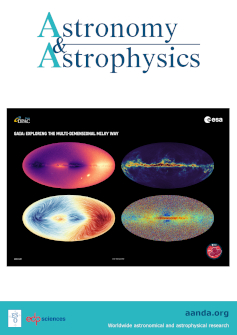詹姆斯-韦伯太空望远镜揭示的木卫三上斑驳的二氧化碳外大气层
IF 5.4
2区 物理与天体物理
Q1 ASTRONOMY & ASTROPHYSICS
引用次数: 0
摘要
木星的冰质卫星木卫三有一个微弱的外大气层,它是由水冰的溅射和可能的升华产生的。迄今为止,在这个外大气层中只直接探测到了原子氢和氧。在这里,我们介绍利用詹姆斯-韦伯太空望远镜对木卫三的二氧化碳外大气层进行的观测。在不同类型的地形上都观测到了二氧化碳气体,主要是那些暴露在强烈的木卫三等离子体辐照下的地形,以及一些明亮或黑暗的地形。尽管地表温度较高,但赤道亚太阳区域的二氧化碳丰度较低。在前半球的北极顶上,二氧化碳蒸气的丰度最高,表面压力达到 1 pbar。通过建模,我们发现在该区域当地时间 12 h 附近观测到的局部增强现象可以用冷阱的存在导致二氧化碳吸附来解释。然而,该高纬度地区的释放机制是溅射还是升华仍不清楚。前半球的北极帽也具有独特的表面冰特性,这可能与该地区大气中二氧化碳大量过剩有关。这些 CO2 分子最初可能是在 CO2 前体的放射性分解后释放到大气中的,或者是嵌入 H2O 冰基岩中的 CO2 溅射产生的。黑暗地形(regiones)在南北两极地区更为普遍,可能蕴藏着二氧化碳前体。然后,二氧化碳分子会通过冷阱重新分布在极冠的富冰地形上,并在这些地形上日复一日地释放和重新沉积。木卫二的二氧化碳外大气层凸显了木星冰质伽利略卫星表面-大气层相互作用的复杂性。本文章由计算机程序翻译,如有差异,请以英文原文为准。
A patchy CO2 exosphere on Ganymede revealed by the James Webb Space Telescope
Jupiter’s icy moon Ganymede has a tenuous exosphere produced by sputtering and possibly sublimation of water ice. To date, only atomic hydrogen and oxygen have been directly detected in this exosphere. Here, we present observations of Ganymede’s CO2 exosphere obtained with the James Webb Space Telescope. CO2 gas is observed over different terrain types, mainly over those exposed to intense Jovian plasma irradiation, as well as over some bright or dark terrains. Despite warm surface temperatures, the CO2 abundance over equatorial subsolar regions is low. CO2 vapor has the highest abundance over the north polar cap of the leading hemisphere, reaching a surface pressure of 1 pbar. From modeling we show that the local enhancement observed near 12 h local time in this region can be explained by the presence of cold traps enabling CO2 adsorption. However, whether the release mechanism in this high-latitude region is sputtering or sublimation remains unclear. The north polar cap of the leading hemisphere also has unique surface-ice properties, probably linked to the presence of the large atmospheric CO2 excess over this region. These CO2 molecules might have been initially released in the atmosphere after the radiolysis of CO2 precursors, or from the sputtering of CO2 embedded in the H2O ice bedrock. Dark terrains (regiones), more widespread on the north versus south polar regions, possibly harbor CO2 precursors. CO2 molecules would then be redistributed via cold trapping on ice-rich terrains of the polar cap and be diurnally released and redeposited on these terrains. Ganymede’s CO2 exosphere highlights the complexity of surface-atmosphere interactions on Jupiter’s icy Galilean moons.
求助全文
通过发布文献求助,成功后即可免费获取论文全文。
去求助
来源期刊

Astronomy & Astrophysics
地学天文-天文与天体物理
CiteScore
10.20
自引率
27.70%
发文量
2105
审稿时长
1-2 weeks
期刊介绍:
Astronomy & Astrophysics is an international Journal that publishes papers on all aspects of astronomy and astrophysics (theoretical, observational, and instrumental) independently of the techniques used to obtain the results.
 求助内容:
求助内容: 应助结果提醒方式:
应助结果提醒方式:


